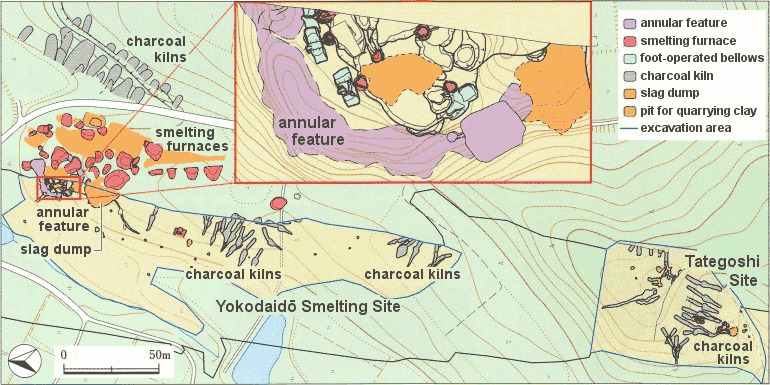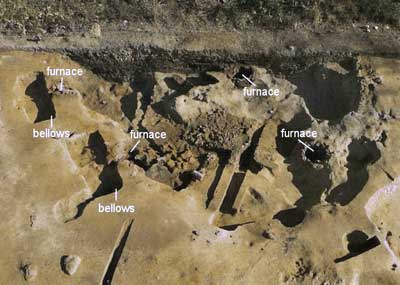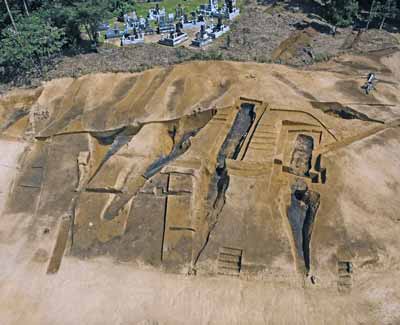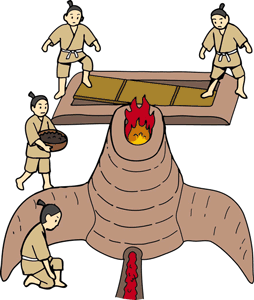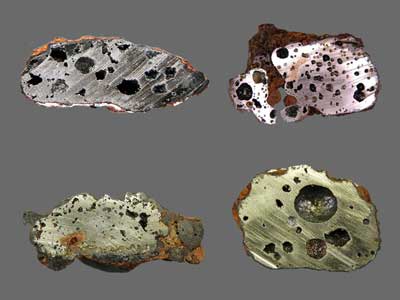Yokodaidō:
Large-scale iron smelting features and evidence for change in technology, unfolding in one of Japan's largest iron producing regions.
Yokodaidō Iron Smelting Historic Site, Minamisōma City, Fukushima Prefecture
Discovery of a large-scale iron furnace group
The Yokodaidō Iron Smelting Historic Site, located in the Pacific coastal region of Fukushima prefecture, is an iron smelting site from the Nara to the Heian periods (eighth to the latter half of the ninth centuries). Chimney-shaped bloomeries (furnaces) were found within an annular feature (a doughnut-shaped mound of earth) of the Nara period, and to its south and southeast were a group of Heian period iron furnaces, dumping grounds for slag, and charcoal-making kilns. The site is situated on a hilltop 40-50 m in elevation, about 7 km distant from the coastline.
The Nara period annular feature was around 20 m diameter in scale, made by digging approximately 1.5 m down in the center and piling the dirt in a ring around the circumference. Six chimney furnaces were placed inside. It is thought that the large-scale earthwork was made in order to set up the furnaces in planned fashion.
Iron technology changes in the Heian period
Five meters south of the annular feature, approximately 60 tons of material related to the operation of box-shaped furnaces, such as furnace wall fragments and iron slag, were recovered from a Heian period dumping ground. The furnaces producing this discharge were on the eastern side of the investigated sector, and it is anticipated that a large-scale group of box-shaped furnaces unfolds over the surrounding area. It is thought that the main basis of iron production changed in the Heian period, from the Nara era chimney furnaces to smelting in these box-shaped facilities.
In addition, 26 subterranean kilns for making charcoal have been ascertained. These were built in concentrated fashion on a single slope, with the shape, size, and method of construction being very similar. From this it is inferred that the same craftsman was most likely involved in all of the kilns, which were operated over a short period of time.
The coastal area of Fukushima prefecture is rich in iron sand which serves as a source of iron, and in ancient times was one of the foremost iron-producing regions in the entire country. At the Yokodaidō Iron Smelting Historic Site, furnaces for smelting iron, dumping grounds for slag, and kilns for making charcoal are preserved as a set in good condition, and it can be called a vital site for considering aspects of ancient iron production such as the introduction of chimney-shaped furnaces. (Kadowaki Hidenori)
Ancient policy towards the Emishi and the productive system of Mutsu and Hitachi provinces
In the Ancient period, people called "Emishi" by the central authority lived in the Tōhoku region. There were frequent clashes between the central administration, which aimed to expand its sphere of influence, and the Emishi who did not comply, and many such incidents are seen in entries of the Nihon shoki chronicle from the latter half of the seventh century.
Disputes between the political center and the Emishi grew increasingly violent in the Nara period. As if to stake out their newly won territories, the central administration established fortresses (jōsaku), government offices combined with military installations, in the central portions of lands it wrested from Emishi control, and also at the front lines of the conflict.
In 774, the dispute between the two sides escalated into a prolonged war. The fighting which came to be known as the "Thirty-eight-year War" started when Ōtomo no Surugamaro, appointed "Barbarian-subduing Generalissimo" by Emperor Kōnin, struck back at Emishi who invaded Monou castle, and lasted until 811 when the then Generalissimo Fun'ya no Watamaro pleaded with the Emperor to put an end to the conflict.
The period when iron production was conducted at the Yokodaidō Iron Smelting Historic Site, from the latter half of the eighth to the latter half of the ninth centuries, coincides with this time of ruthless battle between the central authority and the Emishi. The Pacific coastal region of Fukushima prefecture yields iron sand in plentiful amounts, and at the time was among the first rank of iron-producing zones in Japan. Large-scale iron smelting and casting sites have been verified not only at Yokodaidō, but repeatedly in this area. It is thought that in order to sustain long-term organized iron production, which requires large-scale forestry, the central government was involved.
Iron was produced in great quantity as the raw material for iron tools used at fortresses on the front lines during the period of conflict with the Emishi. Through clarification of these sites, conditions of this conflict that cannot be learned from historical documents come to light. (Ōmi Toshihide)
Adapted from Hakkutsu sareta Nihon rettō 2011 [Excavations in the Japanese Archipelago, 2011] (Bunkachō [Agency for Cultural Affairs], ed., Asahi Shimbun Publications, 2011).
